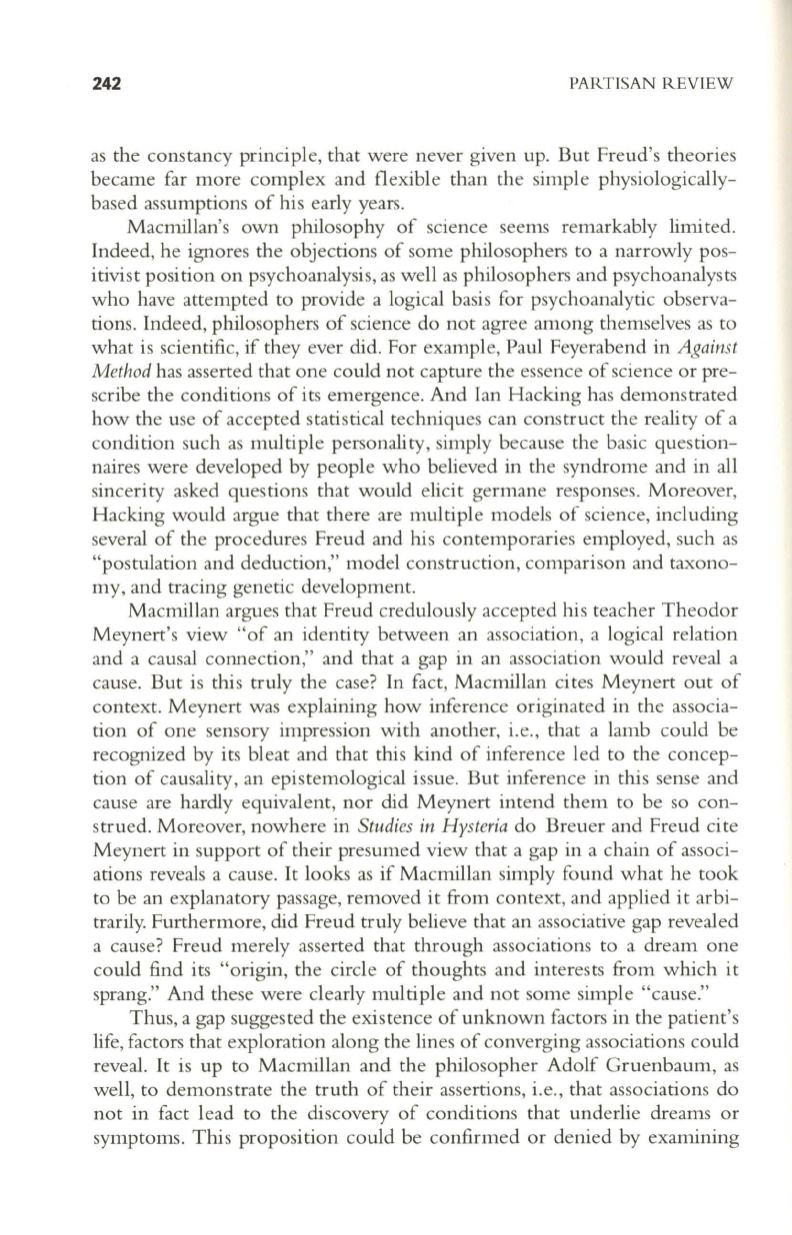
242
PARTISAN REVIEW
as the constancy principle, that were never given up. But Freud's theories
became far more complex and flexible than the simple physiologically–
based assumptions of his early years.
Macmillan's own philosophy of science seems remarkably limited.
Indeed, he ignores the objections of some philosophers to a narrowly pos–
itivist position on psychoanalysis, as well as philosophers and psychoanalysts
who have attempted to provide a logical basis for psychoanalytic observa–
tions. Indeed, philosophers of science do not agree among themselves as to
what is scientific, if they ever did. For example, Paul Feyerabend in
Against
Method
has asserted that one could not capture the essence of science or pre–
scribe the conditions of its emergence. And Ian Hacking has demonstrated
how the use of accepted statistical techniques can construct the reality of a
condition such as multiple personality, simply because the basic question–
naires were developed by people who believed in the syndrome and in all
sincerity asked questions that would elicit germane responses. Moreover,
Hacking would argue that there are multiple models of science, including
several of the procedures Freud and his contemporaries employed, such as
"postulation and deduction," model construction, comparison and taxono–
my, and tracing genetic development.
Macmillan argues that Freud credulously accepted his teacher Theodor
Meynert's view "of an identity between an association, a logical relation
and a causal connection," and that a gap in an association would reveal a
cause. But is this truly the case? In fact, Macmillan cites Meynert out of
context. Meynert was explaining how inference originated in the associa–
tion of one sensory impression with another, i.e. , that a lamb could be
recognized by its bleat and that this kind of inference led to the concep–
tion of causality, an epistemological issue. But inference in this sense and
cause are hardly equivalent, nor did Meynert intend them to be so con–
strued. Moreover, nowhere in
Studies
in
Hysteria
do Breuer and Freud cite
Meynert in support of their presumed view that a gap in a chain of associ–
ations reveals a cause.
It
looks as if Macmillan simply found what he took
to be an explanatory passage, removed it from context, and applied it arbi–
trarily. Furthermore, did Freud truly believe that an associative gap revealed
a cause? Freud merely asserted that through associations to a dream one
could find its "origin, the circle of thoughts and interests from which it
sprang." And these were clearly multiple and not some simple "cause."
Thus, a gap suggested the existence of unknown factors in the patient's
life, factors that exploration along the lines of converging associations could
reveal.
It
is up to Macmillan and the philosopher Adolf Gruenbaum, as
well, to demonstrate the truth of their assertions, i.e., that associations do
not in fact lead to the discovery of conditions that underlie dreams or
symptoms. This proposition could be confirmed or denied by examining


